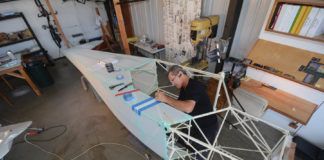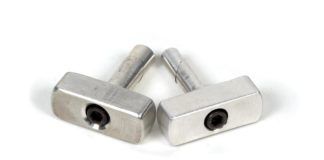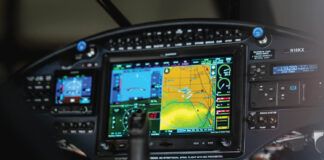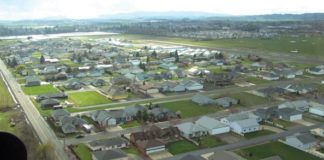The last step we discussed in the fabric-covering process was attaching fabric to the wings and control surfaces. This attachment of fabric to wingribs, etc. is necessary to prevent the fabric from ballooning up during flight. Lift on a wing or control surface will create an upward force on fabric sufficient to actually raise the fabric off of the ribs. For this reason fabric must be adequately attached to the ribs. This is normally accomplished using rib-lacing cord to tie the fabric to the ribs. Alternate methods of attachment include screws, rivets and fabric clips. Whichever method you use, this step is important and must be done properly to ensure safety of flight.
Once the attachment is made, it is necessary to place a strip of fabric tape over the area. You can picture how unsightly screws, rivets or rib-lacing cord would be if left uncovered. Adding tape also provides additional strength to the area. What material is used to make this tape, what widths of tape are available, where should they be applied, and how do you apply them to a surface? Those are the subjects of this months installment.
Roll Tape
When an airplane is covered, numerous areas require fabric tape, referred to as finishing tape. The tape serves to reinforce or strengthen an area, protect fabric from abrasion and cuts, and is applied for cosmetic reasons. Tapes are made from the same polyester fabric that you will use to cover your airplane. The fabric-covering manufacturer cuts the fabric into tapes of varying widths, ranging from 1 to 6 inches. The most common tape used on airplanes is 2 inches wide. The tape is actually cut leaving pinked edges, which are used to increase the amount of surface that can adhere to the aircraft fabric when the tape is cemented in place. The actual edge area that will be cemented in place increases over 40% using pinked-edge tape versus straight-edge tape. Pinking allows the tape to be held more firmly in place than would be possible without it.
Finishing tapes are cut from two different weights of fabric-light weight and medium weight. Light weight fabric weighs about 1.7 ounces per square yard, and medium weight about 2.7 ounces per square yard. Either of these tapes may be used with any weight of fabric. In other words, if you are using medium weight fabric, you may use either light weight tapes or medium weight tapes. A number of people with covering experience find that the light weight tapes are easier to work with and provide a more pleasing appearance on a surface. The choice is yours.
Tapes are normally cut lengthwise with the roll of fabric. These are referred to as linear tapes. After being cut they are then rolled into lengths of 25 to 50 yards, so when you buy a roll of tape from a supply house it will be either 25 or 50 yards long.
Curves Ahead
It is often necessary to tape a curved area. How do you get the tapes to lay down neatly and adhere to the surface? There are a few tricks we will outline later, but you should be aware that special cut tapes, called bias tapes, are available just for curved surfaces. These special tapes are cut at 45 angles to the fabric weave, and they are available in various widths just as regular tapes. Fabric is milled in widths of approximately 70 inches, so its impossible to cut long lengths of tape on a bias. Consequently, bias tapes will have a sewn seam every 70 inches or so. This has obvious cosmetic disadvantages when you’re trying to use a bias tape over a long area. If you are taping the leading edge of a wing, for example, you can use linear cut tape for most of the leading edge and then place bias tape around the wingtip area. More on this later.
To summarize, finishing tapes are cut from light weight or medium weight fabric. Two-inch tapes are the standard width for most ribs and longerons, and you will use more 2-inch tape than any other width. Three-inch-wide tapes are used for leading or trailing edges of wings and control surfaces; 4- and 6-inch widths are used for larger leading edges of wings.
Where to Use Them
Finishing tapes will be applied over all ribs that have been rib-laced or where screws or other attachment methods are used to secure the fabric. Any fabric seam that has been sewn together or glued using fabric cement requires a finishing tape to reinforce the area. Remember earlier discussions where we talked about overlapping and cementing fabric? The resulting seam where the fabric was overlapped should have at least a 2-inch tape placed over it. Other areas need to be reinforced for added strength, and using finishing tapes accomplishes this objective. For example, the very aft portion of a metal or wood wings leading edge requires a finishing tape. If this area is left without it, a spanwise crack will often develop.
Trailing edges of wings and controls should be reinforced with finishing tapes. Leading edges also require taping. Longerons and stringers on a fuselage are usually taped. The leading edge of gear legs is another area where tape should be applied. In short, any area that is subject to abrasion or any area you think needs to be reinforced should be taped.
Selecting and Applying Tapes
Selection of the right size and type of finishing tape is important. You will want to cover the area completely and neatly. As mentioned, 2-inch tape is normally used over wingribs. Leading and trailing edges of wings and control surfaces will often require a wider tape such as the 3- or 4-inch. Some leading edges will need to have 6-inch wide tapes applied for optimum protection. It depends entirely upon the size of the wing, but 2- or 3-inch tape is satisfactory for most trailing edges. Sewn seams should have at least 2-inch tapes applied over them.
Where should you use bias-cut tapes? This is a personal choice. Some experienced coverers do not use bias-cut tapes at all. They work with linear tapes to cover curved areas. If the curve is fairly pronounced, such as on a rudder, I would recommend using bias tapes. Bias tapes are often used on wingtips as well. Remember that the seam found on a bias tape should be removed for cosmetic reasons. A bias cut tape will also become somewhat narrower when pulled tight around a curve. For this reason, you will normally want to use 3-inch bias tapes. A 3-inch tape pulled tight around a curve will narrow to about 2 inches or by roughly a third. Bias cut tapes will lay flat around a curved area, whereas linear-cut tapes will leave wrinkles when pulled around a curve. Use bias-cut tapes only on curved areas.
Now lets get down to the business of applying tapes. With the Poly-Fiber process, tapes are cemented in place using Poly-Brush. Do not use Poly-Tak fabric cement to hold tapes to the fabric. Poly-Tak cement dries much too brittle for the flexible bond tapes need. Also, do not mix Poly-Tak with Poly-Brush. As you will recall, one of the warnings we have discussed throughout this series is to be sure you follow the instructions in the procedure manual.
Lets take a wing that has been rib-laced and apply the finishing tapes over the ribs. I recommend that you draw pencil lines where you want to apply a tape. Using a straight edge to accomplish this task only takes a few minutes. Mark the area just a bit wider than the tape to ensure proper edge adhesion. After marking where the tape will go, you then pre-coat only that area with Poly-Brush. Thin the Poly-Brush with reducer-three parts of Poly-Brush to one part of reducer. It is important that you pre-coat the area prior to placing the tape. This will ensure proper adhesion to the fabric.
In taping a wing, you have two choices. You can either cut the tape for one side of the surface then cut another piece for the other side and then butt them together at the leading edge, or you can cut a piece of tape long enough to wrap around the entire wing surface. I think the latter is easiest to do. So cut a piece of 2-inch tape long enough to wrap around the whole wing, leaving a small amount as extra. Attach the tape to the top of the wing first. You can roll up the tape at the leading edge and clip it with a clothespin to keep it off the floor.
After you have pre-coated the area to be taped, you will then brush another very wet strip of Poly-Brush over the area just pre-coated. (Be careful not to get excess Poly-Brush outside of the lines drawn.) You will need to work fairly rapidly in higher temperatures, as the Poly-Brush will dry quickly. Immediately lay the tape onto the area just brushed. The tape will begin soaking up the Poly-Brush right away. Use your brush to then go back over the tape to make it smooth and work out any air bubbles. Little brushing is needed, and be sure to complete any brushing before the Poly-Brush dries. If you dont, there will be brush marks that are difficult to remove. It is also important that you have the first one-half inch of each side of the tape thoroughly wetted out with Poly-Brush, thus ensuring that the edges of the tape will not lift.
Dont worry about small wrinkles, air bubbles or an occasional pinked edge that is not in place. We will work those out later. As soon as the Poly-Brush dries, apply one more coat over the tape itself. Again, watch those brush marks.
Turn the wing over and repeat this process on the bottom side of the wing. You may notice some wrinkles where the tape wraps around the leading edge of the wing. This will be more of a problem on tapered-wing aircraft. We will talk about working these out in the next installment of the series.
You have now learned what tapes are available, where to use them, and the first steps in applying them. Next month we will continue this discussion with taping curved areas, leading edges and more.













